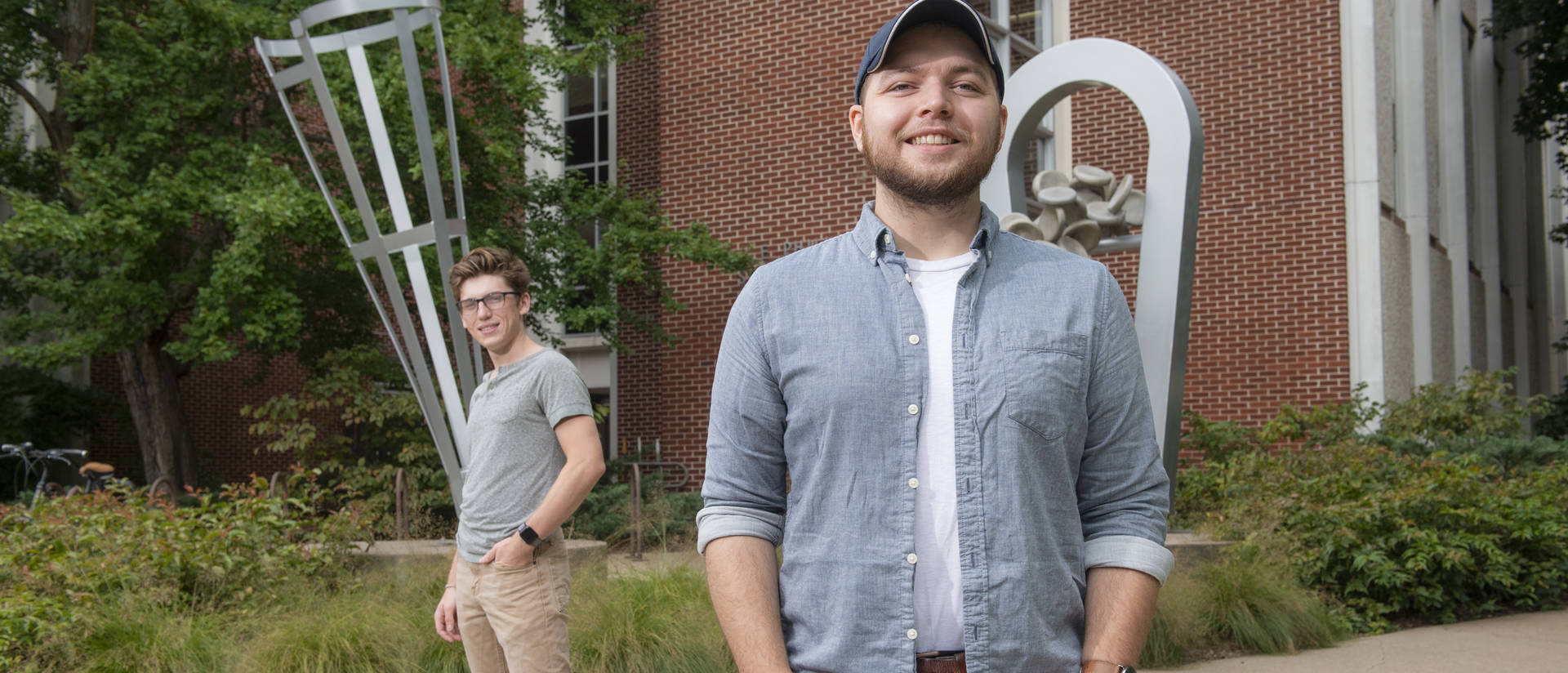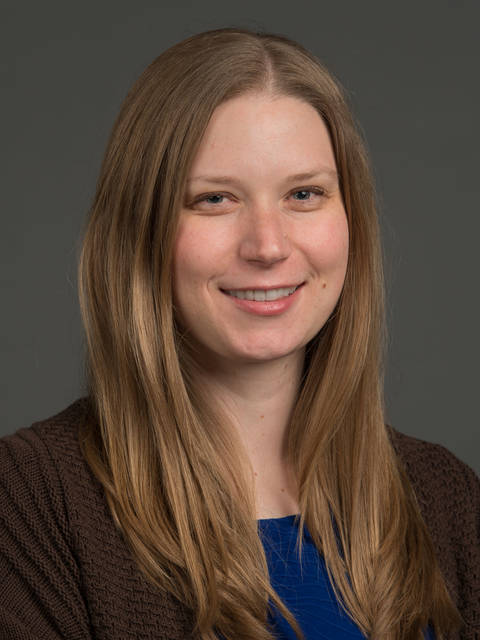
Blugolds find faculty-student research project difficult to leave
‘Once-in-a-lifetime project’ no small feat
By Gary Johnson
Photo caption: UW-Eau Claire student researchers Aaron Ellefson, right, and Cuyler Monahan participated in student-faculty research to develop a clinical foam to protect cancer patients during treatment.
Seniors Aaron Ellefson and Cuyler Monahan are eager to graduate this year, but admittedly reluctant to leave a collaborative medical research project that has been a significant part of their University of Wisconsin-Eau Claire educations.
Ellefson and Monahan, who will graduate in May and December, respectively, will leave UW-Eau Claire with materials science degrees and a wealth of knowledge and research experience from their time spent with Dr. Elizabeth Glogowski, an associate professor of materials science and engineering, and Dr. Jeremy McBride, a Mayo Clinic Health System interventional radiologist.
“It has been one of the best experiences I've had at UW-Eau Claire and brings the materials science discipline to life,” Ellefson says. “This is a once-in-a-lifetime project and what we have accomplished is no small feat.”
“It has been one of the best experiences I've had at UW-Eau Claire and brings the materials science discipline to life,” Ellefson says.
The collaborative research team is developing an injectable clinical foam to protect cancer patients from damaging healthy tissue during treatment. The project has advanced to the next stage of testing, with encouraging results, McBride says, adding that “testing is ongoing.”
“I'm optimistic that this could be a product that will be useful in insulating vital tissues from the ablation energy used to destroy tumors in patients,” McBride says. “I'm also excited about additives we are working on that will significantly broaden the potential application of the foam for different clinical scenarios.”
McBride started working on the idea of an injectable foam more than six years ago during his training at Mayo Clinic in Rochester, Minnesota. When his hospital duties in Eau Claire limited his research time, McBride contacted UW-Eau Claire’s materials science and engineering department because of the health system’s collaborative research agreement with the university.
The injectable foam idea fit with Glogowski’s research experience in soft materials. The Materials Science and Engineering Center at UW-Eau Claire funded a pilot study in spring 2019 and supported student researchers in a test to see if the project was feasible, Glogowski says. Funding from Mayo Clinic Health System in Eau Claire assisted the student work.
Ellefson, a native of Eden Prairie, Minnesota, and Monahan, who is from Mount Horeb, received the Tim Higgins Innovation Award and a $500 prize in the WiSys 2020 Student Research & Innovation Showcase this past summer for “demonstrating significant innovative, economic and societal impact” for their work on the injectable foam project.
WiSys is an independent, nonprofit organization that assists patent technologies developed in UW System schools and works with companies on the inventions.
Monahan and Ellefson are appreciative of the WiSys recognition. They outlined their project to judges during a five-minute virtual presentation because of the COVID-19 pandemic.
“The WiSys award was confirmation that our work has meaning to people outside of Eau Claire and even outside of Wisconsin,” Monahan says.
“The WiSys award was confirmation that our work has meaning to people outside of Eau Claire and even outside of Wisconsin,” Monahan says.
McBride says he was excited when he heard the news that the student researchers were award winners.
“Scientifically, they did a great job with their experiments, their testing and the way they reported their data,” McBride says. “I think the potential for clinical application also helped create interest in this project, both as far as interest from the outside and generating enthusiasm and interest for Aaron and Cuyler.”
Ellefson and Monahan used the creativity and problem-solving abilities they learned in materials science courses and applied them to the research project, Glogowski says.
The student researchers accepted Glogowski’s “open-ended guidance” as she asked them to use advanced research skills to develop and implement testing methods.
Glogowski says the hard work, dedication and creativity of Ellefson and Monahan helped make the research successful.

Dr. Elizabeth Glogowski, associate professor of materials science and engineering
“They’ve taken it to the next level from learning how to do things in their courses to applying it to a real-world application,” Glogowski says. “It’s been a true collaboration with the students, myself and Dr. McBride.”
The collaboration has turned out better than McBride had even hoped. The physician praised Glogowski for helping the students prepare for and run the experiments.
“We complement each other well on what we bring to the table,” McBride says of Glogowski. “She works very well as a mentor and in helping the students get the science and testing done. I have the clinical perspective and understanding of the biologic system. It really has been a very easy and productive collaborative relationship.”
With Ellefson graduating in May and Monahan finishing his UW-Eau Claire undergraduate studies in December, Glogowski has two new research students who joined the project in fall 2020 — freshmen Kira Haus and Marshall Apps. The new team members are part of the new Blugold Biomedical Innovator Program for students who intend to pursue a degree and career path in the health care or biomedical field.
“They have really stepped up and been an enthusiastic part of the project, in spite of COVID making things more difficult,” Glogowski says of the new research team members.
Haus, an Elk River, Minnesota, native who is majoring in UW-Eau Claire’s new biomedical engineering program and minoring in pre-professional health sciences, praised Glogowski for her support, and Ellefson and Monahan for their guidance.
“When I initially enrolled at UWEC, I knew that undergraduate research was popular and something that differentiated UWEC from so many other schools,” says Haus, who plans to enroll in a physician assistant program after graduating from UW-Eau Claire. “It was not until I had heard about the Blugold Biomedical Innovator Program that I learned that doing life-changing research as a freshman was possible.”
Apps, who is from Green Bay and majoring in biochemistry/molecular biology with a Spanish minor, agreed that such significant research is unique for first-year students.
“This project is really intriguing and thought-provoking because before this project, I never even thought that undergraduate research had the potential to change major techniques in science,” says Apps, who hopes to apply to medical school after completing his undergraduate studies. “I think that is quite amazing, and I am excited to work on this project because of its connection to the medical field.”
As he prepares to leave UW-Eau Claire, Ellefson says research opportunities such as the clinical foam project are exactly what he had in mind when he decided to attend UW-Eau Claire.
“Involving students in research means tapping into bright minds that are eager to shape the future,” Ellefson says. “The substantial involvement of undergraduate students in research is a big draw for this school. I have had tons of hands-on experiences that are sometimes only available to graduate students at other universities. Time in the lab can't be done online and makes a distinctive choice for education in a time of growth for off-site learning.”
To view Ellefson and Monahan's WySis presentation, follow this YouTube link.
The substantial involvement of undergraduate students in research is a big draw for this school. I have had tons of hands-on experiences that are sometimes only available to graduate students at other universities.
Support Materials Science department
Support STEM research at UW-Eau Claire
For every inspiring student researcher like Aaron Ellefson and Cuyler Monahan, there are hundreds more Blugolds in STEM hoping to have the chance to partake in this kind of collaborative research, making a difference in the lives of real people. Your gift to STEM departments or the Biomedical Innovators Scholars fund can help ensure this work well into the future.
Explore more opportunities to make a difference for students